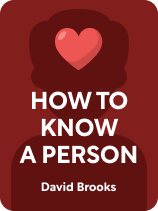

This article is an excerpt from the Shortform book guide to "How to Know a Person" by David Brooks. Shortform has the world's best summaries and analyses of books you should be reading.
Like this article? Sign up for a free trial here.
Do you want to make people feel seen? How can you appear interested in what people are sharing with you?
David Brooks explains that it’s crucial to interact with others in ways that show them you appreciate them and want to understand them. This involves several skills you can practice every day, such as being open to what people share with you.
Here’s how Brooks recommends learning how to make someone feel seen.
1. Open Yourself Up to What People Share With You
To know how to make someone feel seen, you first have to make it clear that you want to get to know them. Brooks says you can do this by opening yourself up to others’ ideas, experiences, and perspectives. Make a point of listening closely when they share with you: They’ll realize you’re open to what they’d like to share if you’re generous as a listener when they tell you about themselves.
The goal isn’t just to listen for the sake of it. Instead, it’s to develop a respectful understanding of a person’s contradictions, uncertainty, and struggles. Only by opening yourself up to what people share with you can you witness the dignity with which they handle the challenges they encounter in their life.
(Shortform note: Psychologists agree with Brooks that being open to what others share is an important part of making sure they know you value them. In Platonic, Marisa Franco explains that expressing your appreciation for others is crucial for strengthening your bonds with them, even if it feels awkward at first. Simple acts like telling a friend you’re grateful for them or complimenting their achievements can make a big difference. Franco also suggests that being generous with your unique skills is a great way to show other people you value them. Plus, opening up about your own struggles, joys, and even guilty pleasures can deepen your friendships, as vulnerability tends to be met with acceptance more often than we expect.)
2. Be Present With People Through Everyday Experiences
A second way to show people you see and value them is to be present in the moments you share with them each day, even when you’re doing something routine. Brooks notes that you probably spend most of your time doing the mundane things that make up everyday life: collaborating on projects with your coworkers, cooking dinner with your partner, driving to school with your kids, striking up a conversation with the neighbors, and so on. He recommends learning to see these moments as chances to engage with the people you share them with: to bring your whole self to those moments and to enjoy seeing how others navigate their lives.
Brooks explains that when you do something with another person, like writing code together or looking at the same painting, you’re often side-by-side with them—but you may see things differently from your seemingly similar vantage points. Focusing on something together is an opportunity to see their unique perspective.
(Shortform note: Brooks’s advice on being present in everyday moments aligns with the Zen Buddhist emphasis on living in the present moment. Zen Buddhists, like Alan Watts (The Way of Zen), view life as existing only in the present. They believe our tendency to dwell on the past or future often prevents us from experiencing the richness of the present moment. To them, life has no inherent meaning beyond the experience itself. So by fully engaging in the kinds of activities that Brooks points out we often do with others, you might gain a deeper appreciation for the transient nature of existence and the interconnectedness of all things)
3. Engage and Improve Your Conversational Skills
A third crucial tool for helping others feel understood is simply to engage them in a great conversation. Brooks explains that you can have compelling, enriching conversations even with people you’re still getting to know. That’s especially true if you make a point of cultivating your conversational skills. To turn everyday encounters into a chance to get to know someone better, you have to hone your ability to listen. Brooks explains that we often fail to really listen to one another, but that’s a bad habit you can break with a little bit of work.
Brooks recommends using active listening techniques to engage with what the other person says—and to signal to them that you’re really paying attention. By paraphrasing or summarizing your understanding of what you’re hearing as the other person speaks, you can check in with them and make sure you’re on the same page with them. You can also use nonverbal cues—like maintaining eye contact, leaning in when the other person speaks, and nodding your head—to show them how engaged you are. If they feel confident that you’re really listening, that can help them feel more comfortable sharing their thoughts and their perspective with you.
Even conversations about mundane topics offer you a chance to connect with someone, according to Brooks. If you can make people feel valued when you’re talking about the traffic in your neighborhood or comparing notes on the movie you both saw over the weekend, you’re well on your way to building a meaningful relationship with them.

———End of Preview———
Like what you just read? Read the rest of the world's best book summary and analysis of David Brooks's "How to Know a Person" at Shortform.
Here's what you'll find in our full How to Know a Person summary:
- The benefits of really getting to know other people
- How to better understand people on a personal level
- Why our morality and relationships are in a crisis






